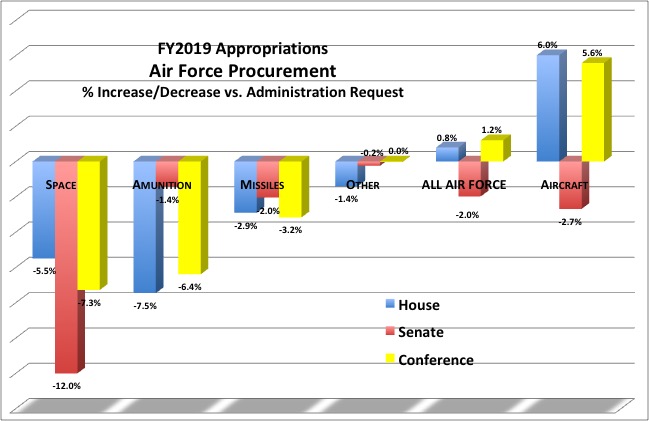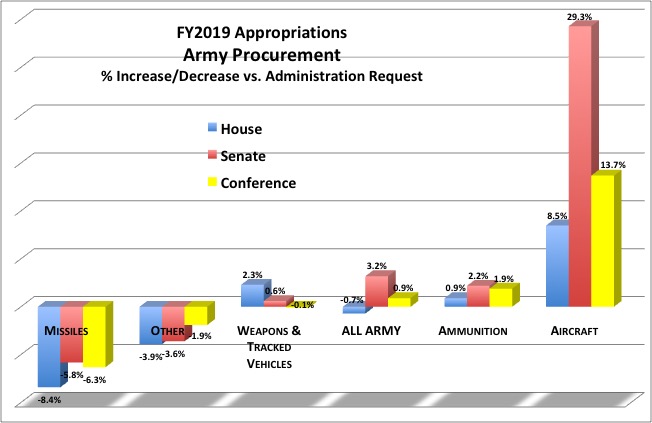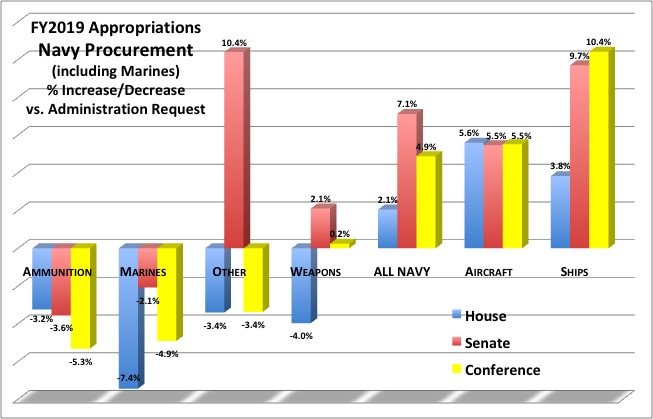WASHINGTON: The big news about the $674.4 billion defense appropriation that conferees agreed to yesterday is that, for the first time in nine years, it’s on time. That’s a big relief to defense officials and contractors used to limping along on restrictive Continuing Resolutions for the first months of the fiscal year until Congress finally passes a proper spending bill. Given that the Budget Control Act caps (aka sequester) return in 2020, next year probably won’t go as smoothly.
But in a budget this big, even the “small” items are billions of dollars, and there are plenty of devils in them thar details. We dumped the procurement figures from the House-Senate appropriations conference report into Excel and found some fascinating patterns in the $135.3 billion Congress gave the Pentagon to buy equipment.
- Aircraft of all kinds were the overall winner this year, with the House and Senate agreeing to plus up everything from Army Apache helicopters to Air National Guard C-130 transports to F-35 Joint Strike Fighters. All three military departments – the Army, Air Force, and Navy (which includes the Marine Corps) – got more aviation funding than they’d requested in the President’s Budget submitted back in February. That’s particularly surprising because the Senate had wanted to cut Air Force aircraft procurement, not increase it, while the House wanted to boost Army aviation more than three times more than the Senate proposed. In the end, they compromised on a still-striking 13.7 percent increase for Army aviation, 5.6 percent for the Air Force, and 5.5 percent for the Navy (where the two chambers were within a decimal point of each other).
- The biggest single increase came in Navy shipbuilding, which went up 10.4 percent above the administration’s request – more than either the Senate or House had proposed. (You know a program’s popular when heated negotiations produce a compromise above either side’s going-in position). That’s understandable both strategically – China is the most rapidly growing threat, and a Pacific conflict would be mainly maritime – and politically – since shipbuilding provides well-paying, working-class jobs clustered in particular districts. The increase lets the Navy buy 13 new ships, including three of the controversial Littoral Combat Ships, two more than it had requested, which legislators explicitly said was to keep shipbuilders Marinette and Austal going strong so they can both compete for the follow-on frigate program.
But where did all that money come from?
- Air Force space programs took a 7.3 percent cut below what the administration had requested – still a smaller hit than the House’s proposed 12 percent. This drubbing might seem inconsistent with the House-led push to create a Space Force, now endorsed by President Trump. But in fact House strategic forces subcommittee chairman Rep. Mike Rogers felt driven to propose a new service because he and many other members had lost faith in the Air Force’s competence to manage space programs. In this context, it makes sense that, if there’s no Space Force yet (and maybe ever), Congress is leery of handing over more space cash to the Air Force.
- Ammunition and missiles accounts took hits in all three military departments, as did the related Navy weapons accounts. Yes, there’s rhetoric from both chambers that the US needs to replenish stockpiles – especially of precision guided weapons – lest it run out in a major war or even a mid-sized campaign. But it’s simply too easy to nickel and dime these relatively small accounts in order to buy big, sexy platforms like ships and planes. Sure, they may run out of ammo in a fight, but we can always fix that next year, right?
- Most surprisingly, Marine Corps procurement took a significant hit. The Marines are normally politically popular with the public and Congress alike, but this year the House proposed 7.4 percent less for their procurement programs (run by the Navy Department) than the president’s request and the Senate proposed 2.1 percent, with the chambers compromising on 4.9. We’re still figuring out where exactly these reductions came from….
In a ‘world first,’ DARPA project demonstrates AI dogfighting in real jet
“The potential for machine learning in aviation, whether military or civil, is enormous,” said Air Force Col. James Valpiani. “And these fundamental questions of how do we do it, how do we do it safely, how do we train them, are the questions that we are trying to get after.”





























